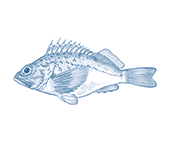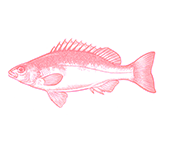




- Better Choice
Wild Caught
Region:
QLD
- Tuskfish refers to a range of wrasse species that have varying degrees of endemicity to Western and Northeastern Australia.
- Tuskfish are caught in a multi-species hook and line fishery along the Great Barrier Reef Coast.
- Tuskfish populations appear healthy, and though there is no sophisticated fishery assessment; catches are low and populations are monitored in and protected by extensive marine park zones.
- The Great Barrier Reef Marine Park provides best practice protection for habitats and the wider marine environment the fishery operates within.
- A range of reforms have been introduced to the fishery's management in recent years, many of which represent best international practice in coral reef fishery management.
QLD Reef Line Fishery (28t in 2020, 40t in 2019)
Tuskfish refers to a range of wrasse species that have varying degrees of endemicity to Western and Northeastern Australia. They are found around shallow coral reef associated habitats. They are long-lived hermaphroditic species that form highly territorial haremic or lek populations. Large mature fish change sex to males depending on local population sex composition. As such they are vulnerable to fishing impacts targeting larger fish, which can result in a shortage of males in a breeding population.
Tuskfish are caught as a secondary species in the multi-species Reef Line Fishery (which targets coral trout and red emperor).
There are no detailed scientific assessments of tuskfish stocks in place. Despite this, catches are low and populations are being effectively protected in extensive Great Barrier Marine Park zones closed to fishing. Marine park managers conduct an ongoing environmental monitoring program which provides evidence that tuskfish populations are likely to be stable across the main fishing grounds, with some evidence of recovery following a cyclone impact in 2016..
The impacts of line fishing on the marine environment are minimal. In QLD, fishing takes place around the Great Barrier Reef Marine Park, which provides world-class science-based protection and monitoring of habitats and the wider ecosystem in the area of these fisheries. Recently established vessel monitoring systems are ensuring fishers are compliant with marine park regulations.
Serious climate-related environmental impacts in the forms of cyclone damage and coral bleaching events (where coral is under stress due to warm ocean waters) have occurred on the Great Barrier Reef in recent years. It is welcome that fishery and environmental managers are monitoring and managing these factors, with new measures designed to maintain species caught in the wider fishery at abundant and environmentally resilient population sizes.
It is likely the line fisheries in QLD pose minimal risk to most other species. Independent fishery observer programs are an important method of verifying protected species interactions, as well as other fishery impacts, such as the type and volume of discarded catch. Unfortunately the QLD Government closed the observer program for all QLD managed fisheries in 2012. In the intervening six years, there has been no independent scrutiny of the impact of the fishery on other species.
Despite this issue, a range of other reforms have been implemented across the fishery since the last GoodFish assessment, many of which represent international best practice and have contributed significantly to the ‘better choice’ ranking of the fishery in this assessment.


